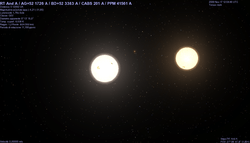RT Andromedae
 RT Andromedae system. | |
| Observation data Epoch J2000.0 Equinox J2000.0 | |
|---|---|
| Constellation | Andromeda |
| Right ascension | 23h 11m 10.099s[1] |
| Declination | +53° 01′ 33.04″[1] |
| Apparent magnitude (V) | +9.03 |
| Characteristics | |
| Spectral type | G0V / K2V |
| Variable type | RS Canum Venaticorum variable |
| Astrometry | |
| Proper motion (μ) | RA: -7.01 ± 0.79[1] mas/yr Dec.: -20.80 ± 0.77[1] mas/yr |
| Distance | 270.7 ± 6.5 ly (83 ± 2 [2] pc) |
| Details | |
| Mass | 1.1/0.83[2] M☉ |
| Radius | 1.25/0.9[3] R☉ |
| Luminosity | 1.8/0.35 L☉ |
| Temperature | 5900/4674[2] K |
| Age | 4.54 billion years |
| Orbit | |
| Period (P) | 0.001723 yr |
| Semi-major axis (a) | 0.01635 Astronomical Units" |
| Eccentricity (e) | 0.011 |
| Inclination (i) | 87.6[2]° |
| Other designations | |
V* RT And, CABS 201, GSC 03998-02167, PPM 41561, AG+52 1726, CCABS 163, SBC7 953, AN 79.1901, CSI+52 3383 1, HIP 114484, TYC 3998-2167-1, BD+52 3383a, GCRV 14555, 2MASS J23111009+5301330 | |
| Database references | |
| SIMBAD | data |
RT Andromedae is a variable star in the constellation of Andromeda. It is classified as a RS Canum Venaticorum variable, a type of close eclipsing binary star, and varies from an apparent visual magnitude of 9.83 at minimum brightness to a magnitude of 8.97 at maximum brightness, with a period of 0.6289216 days.[4]
Presence of a third body
According to Pribulla et al. (2000) a third object could be present in the system. Minimum mass is estimated 5 percent of Solar mass (roughly 50 times the mass of Jupiter), orbital period close to 85 years and eccentricity is inferred to be high (e=0.56).[2] Such object could likely turn out a brown dwarf or even a massive jovian planet. Nevertheless, recent paper of Manzoori (2009) states that minimum mass of the third body is likely close to 0.6 Solar masses, making the object stellar rather substellar.[5] Also orbital period turns out longer than 85 years.
| Companion (in order from star) |
Mass | Semimajor axis (AU) |
Orbital period (years) |
Eccentricity | Inclination | Radius |
|---|---|---|---|---|---|---|
| b (retracted) | ≥50-600 MJ | ≈25 | 85-105 | 0.56 | — | — |
References
- 1 2 3 4 van Leeuwen, F. (2007). "Validation of the new Hipparcos reduction". Astronomy and Astrophysics. 474 (2): 653–664. arXiv:0708.1752
 . Bibcode:2007A&A...474..653V. doi:10.1051/0004-6361:20078357. Vizier catalog entry
. Bibcode:2007A&A...474..653V. doi:10.1051/0004-6361:20078357. Vizier catalog entry - 1 2 3 4 5 Pribulla; et al. (2000). "Active eclipsing binary RT Andromedae revisited". Astronomy & Astrophysics. 362: 169–188. Bibcode:2000A&A...362..169P.
- ↑ Dryomova; Perevozkina, E.; Svechnikov, M. (2005). "Catalogue of the orbital elements, masses, and luminosities for short-periodic RS CVn-type eclipsing systems". Astronomy & Astrophysics. 437 (1): 375–381. Bibcode:2005A&A...437..375D. doi:10.1051/0004-6361:20042003.
- ↑ RT And, database entry, Combined General Catalog of Variable Stars (GCVS4.2, 2004 Ed.), N. N. Samus, O. V. Durlevich, et al., CDS ID II/250 Accessed on line 2009-06-22.
- 1 2 Manzoori (2009). "Cyclic Variations of Orbital Period and Long-Term Luminosity in Close Binary RT Andromedae". The Astronomical Journal. 138 (6): 1917–1924. Bibcode:2009AJ....138.1917M. doi:10.1088/0004-6256/138/6/1917.